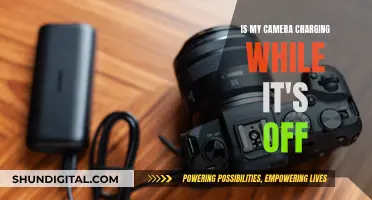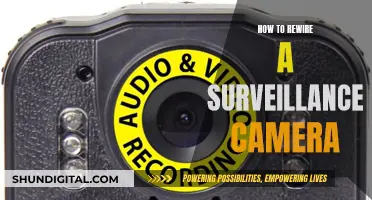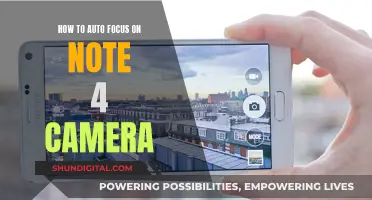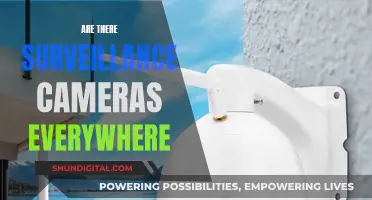
Self-portraits are a fun process but can be frustrating when you can't get the focus right. There are several ways to get the perfect shot, from using a remote control and tripod to setting a reference focus point and switching to manual focus.
One of the most common issues with self-portraits is that the camera focuses on the background rather than the subject. This can be avoided by setting a reference focus point. Simply place an object where you will be posing, focus on that, and then pose in the exact same spot. You can also use your camera's autofocus mechanism by finding the focal point and standing in front of the camera. Landmark elements, such as items in nature, can help you figure out where to stand.
Another issue is that the camera may focus on your nose rather than your eyes. This can be avoided by using a smaller aperture, which increases the depth of field and makes accurate focusing less critical.
With a bit of practice and patience, you can achieve sharp and focused self-portraits that capture the essence of the moment.
What You'll Learn

Use a remote control and tripod
Using a wireless remote control and a tripod is a great way to get sharp and focused self-portraits. Here's a step-by-step guide on how to do it:
Step 1: Set Up Your Tripod
Find a central location with good lighting and adjust the tripod's height and angle to a comfortable position for you. Most tripods allow you to adjust the legs to find a level surface, usually two to three feet off the ground, with room for your camera's lens to tilt upwards slightly. Once you've found the perfect position, make sure the tripod is secure and won't move around.
Step 2: Compose Your Shot
Take a few standard photos of yourself in your surroundings to get a feel for the composition and lighting. Change your poses, expressions, and outfits to add variety to your images. This will be useful when you start taking your self-portraits.
Step 3: Position Yourself in Front of the Tripod
Now, place your camera at eye level and look through the lens to adjust your clothing, hair, expression, and pose. Take a few seconds to find a pose you like, and then start taking pictures every few seconds until you have about 10 shots.
Step 4: Use a Remote Camera Trigger
Using a remote camera trigger, such as a wireless remote control, is a great way to improve your self-portraits. It eliminates the need to run back and forth between the camera and your posing position. You can simply place yourself in front of the camera and trigger the shot remotely, allowing the autofocus to do its job while you're in the image.
Step 5: Choose the Right Tripod
Not all tripods are created equal. For self-portraits, consider investing in a heavier tripod that will keep your camera steadier when taking pictures. Look for tripods with features like a bubble level, compact and lightweight design, and sturdy construction. Some recommended options include the Oben AC-1404, Manfrotto 190, and AmazonBasics 60-Inch Lightweight Tripod.
Step 6: Fine-Tune Your Camera Settings
To ensure sharp and focused self-portraits, adjust your camera settings accordingly. Use a fast shutter speed to "freeze" any movement and choose an appropriate aperture to control the depth of field. Bump up your shutter speed or aperture to make the scene appear darker and avoid focusing problems, especially in low-light conditions.
Step 7: Practice and Experiment
Taking great self-portraits is a skill that requires practice and experimentation. Don't be afraid to try different poses, expressions, and compositions. Remember, it's all about trial and error, and finding what works best for you. With patience and persistence, you'll be amazed at the stunning self-portraits you can create.
The Origin Story of SpyPoint Cameras
You may want to see also

Use an app to see what the camera sees
Using an app to see what your camera sees is a great way to improve your self-portraiture. This method allows you to always ensure you are in focus and then review the photo immediately after taking it.
There are a variety of apps available for both iPhone and Android that can help you with your self-portraiture. Some apps are specific to certain camera brands, such as the Canon Camera Connect app, while others are more general and can be used with any camera.
When choosing an app, look for features such as the ability to control your camera settings, including ISO, aperture, and shutter speed, as well as the ability to review photos and adjust composition in real time. Some apps also offer a self-timer function and the ability to capture movement and time-lapses.
It is also important to consider the type of connection the app uses. Some apps connect to your camera via WiFi, while others use a wired connection. Wireless connections offer more flexibility, especially if you need to be far away from your camera.
By using an app to see what your camera sees, you can save yourself time and effort and improve the overall quality of your self-portraits.
Priority Mode: Understanding Camera's Creative Control Feature
You may want to see also

Pick a fast enough shutter speed and appropriate aperture
When taking self-portraits, it's important to strike the right balance between shutter speed and aperture to ensure your photos are sharp and well-exposed. Here are some tips to help you pick the right settings:
- Shutter Speed: A fast shutter speed is crucial to freeze any movement and prevent blurry photos. The general rule of thumb is to use a shutter speed that's at least equal to or faster than the focal length of your lens. For example, if you're using a 50mm lens, set your shutter speed to at least 1/50th of a second. If you're photographing children or moving subjects, you may need to increase the shutter speed even further to capture sharp images.
- Aperture: Using a wide aperture (low f-number) creates a shallow depth of field, making your subject stand out against a beautifully blurred background. However, this requires precise focusing. For portraits, an aperture range of f/2 to f/8 is commonly used, depending on whether you want a blurry or sharp background. Wider apertures like f/1.4 can be used but require extremely precise focusing to ensure the subject's eyes are sharp.
- ISO: While not directly related to shutter speed and aperture, choosing the right ISO value is crucial for achieving optimal image quality. In well-lit conditions, keep the ISO low (100-400) to minimize noise. When shooting in low light, you may need to increase the ISO, but do so cautiously to avoid excessive noise. Adjust your aperture and shutter speed first, and only increase the ISO if necessary.
- Lighting: In low-light conditions, your camera's autofocus may struggle. You can assist the autofocus by adding a subtle light source, such as a phone torch or an LED ring light, to illuminate your face without affecting the overall scene. Alternatively, increase your shutter speed or aperture to make the scene appear darker and avoid focusing issues.
- Stabilization: Using a tripod and a remote trigger or cable release can significantly improve sharpness by eliminating camera shake. This setup also allows you to use slower shutter speeds when your camera is mounted on a tripod, giving you more flexibility.
Remember, these settings are interdependent, and changing one will impact the others. Always do test shots and review your images to ensure you have the correct focus and exposure before proceeding with your self-portrait session.
Unlocking Single-Camera Portrait Mode: Unraveling the Mystery
You may want to see also

Focus correctly once and then lock the focus, or focus manually
Focusing on yourself when taking a self-portrait can be challenging, but there are some tricks to help you nail the focus. Here are some detailed tips to help you focus correctly and then lock the focus or focus manually:
Set a Reference Focus Point
Place an object, such as a lamp, plant, or even a toy, where you plan to pose for your self-portrait. Focus your camera on this object, and then switch to manual focus mode to lock the focus. Now, when you pose in the exact spot where the object was, the camera will remain focused on you. This technique ensures that you don't have to keep adjusting the focus while also trying to pose for your photo.
Use a Stand-In
A variation of the above method is to use a stand-in, such as another person or an object like a backpack or a rock, to set your focus. Place the stand-in where you plan to pose, and focus on it. If your camera has autofocus, you can use it to focus on the stand-in, and then switch to manual mode to lock the focus. Now, when you go back to the same spot, the camera will be focused on you.
Reverse Focusing
This method is similar to using a stand-in but instead, you use your tripod as the stand-in. Since focusing is based on the distance between the camera and the subject, you can take the camera to where you plan to pose and focus on the tripod head. Mark that spot on the ground, as this is where you will stand for your portrait. Then, put the camera back on the tripod and switch to manual focus mode. Now, when you stand on the marked spot, the camera will be focused on you.
The String Method
If you need very precise focus with a narrow depth of field, try the string method. Tie a string to the tripod head, and then take the camera to where you plan to pose, focusing on the tripod as before. Mark the string where it crosses the film plane (near the back of the camera). Anything at this marked distance from the tripod will be in perfect focus. Put the camera back on the tripod in manual focus mode, stand on your mark, and take the photo.
Use a Flashlight
Most modern cameras have a "closest-subject" focus mode. To take advantage of this, darken the room and shine a flashlight on the area you want to be in focus, such as one of your eyes. The camera will focus only on the illuminated object. Since the room is dark, you will need to use a flash to take the photo.
Measure the Distance
If your lens has distance markings, you can manually set the focus by measuring the distance from the camera to where you will be standing. Simply adjust the focus ring on your lens to match the measured distance.
Focus Manually
If your camera has manual focus mode, you can carefully adjust the focus ring on your lens to achieve the desired focus. This method may take some time and patience, but it gives you precise control over the focus of your image.
Remember, achieving the perfect focus for your self-portraits may require some experimentation with different techniques and settings. Don't be afraid to try out different methods and find what works best for you and your equipment.
Camera Battery Lifespan: How Long Does It Last?
You may want to see also

Move distracting objects from the foreground while you focus
When taking a self-portrait, you may encounter issues with the autofocus of your camera due to "distracting" objects in the foreground, such as leaves or grass. To address this, you can try the following:
Move the object out of the frame
If possible, move the distracting object out of the frame while you focus. This way, you can ensure that the camera's autofocus locks onto your face or eyes, which is typically the desired focal point in a self-portrait. Once you have achieved the desired focus, you can return the object to its original position if you wish to include it in the frame.
Use manual focus
If moving the object is not feasible, you can try switching to manual focus mode. In this mode, you can carefully adjust the focus ring on your lens to achieve the desired focus. This allows you to override the camera's autofocus and ensure that the correct subject is in focus.
Set a reference focus point
Another technique is to use a reference object, such as a lamp or a plant, to set the focus. Place the object where you will be posing, focus on it, and then switch to manual focus mode to lock in the focus. Now, when you pose in the same spot, the focus will remain on you instead of being distracted by objects in the foreground.
Use reverse focusing
A variation of the previous technique is to use your tripod as the stand-in for focusing. Since focusing is based on distance, you can take the camera to your posing spot and focus on the tripod head. Mark that spot and then switch to manual focus mode. This ensures that when you stand at the marked spot, the camera's focus will be on you rather than any foreground objects.
The string method
If you need very precise focus with a narrow depth of field, you can try the string method. Tie a string to the tripod head and focus on that spot. Mark the string where it crosses the film plane (near the back of the camera). Now, anything at that marked distance from the tripod will be in perfect focus. Simply stand at that mark and take the photo, ensuring the camera is in manual focus mode.
Use a flashlight
Many modern cameras have a "closest-subject" focus mode. Take advantage of this by darkening the room and shining a flashlight on the area you want to be in focus, such as your eye. The camera will then focus only on the illuminated object. Remember to use a flash to illuminate the entire scene when taking the photo.
By employing these techniques, you can improve the accuracy of your autofocus and ensure that your self-portraits are sharp and focused as desired.
The Power of Battery Grips: Enhancing Your Camera's Performance
You may want to see also
Frequently asked questions
Place an object where you will be posing, focus on that, and then pose in the same spot.
You can use the object to focus, and then move it out of the frame before taking the photo.
You can use a speed light, which fires a beam of red light to help your camera lock onto your face. Alternatively, you can use a constant light source, such as a phone torch or an LED ring light.
Use a smaller aperture. The smaller the aperture, the wider the depth of field, and the less critical accurate focusing becomes.







